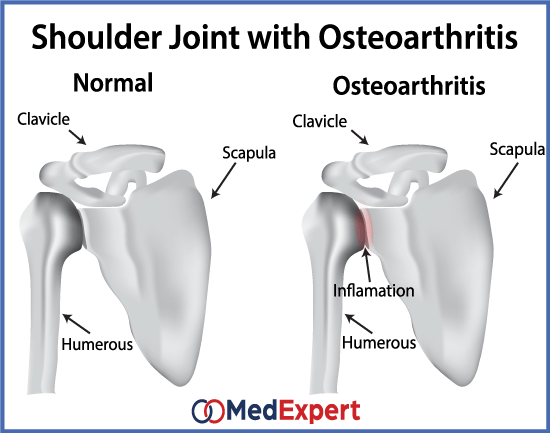SHOULDER OSTEOARTHRITIS (DEGENERATIVE ARTHRITIS OF THE SHOULDER)
Wear-and-tear of cartilage and bony tissue in the shoulder joint is called shoulder osteoarthritis. Shoulder OA treatment may include surgery (shoulder joint replacement) or non-surgical options, but either scenario consists of a whole bunch of measures. Below we are going to talk in detail why does shoulder osteoarthritis occur, how this condition is diagnosed, as well as discuss available shoulder OA treatment options.
This condition is a degenerative joint disease, which can make lifting heavy objects painfully difficult. Osteoarthritis occurs when the articular cartilage in the shoulder degenerates. There are several reasons for developing Shoulder Osteoarthritis and the most common one is aging. But it is also possible to develop Shoulder Osteoarthritis at a young age with injuries such as a shoulder dislocation.

SYMPTOMS OF SHOULDER OSTEOARTHRITIS
Shoulder Osteoarthritis usually develops over time, the symptoms include:
- Pain around shoulders
- Limited mobility
- Crackling or popping sounds
- Stiffness
Advanced Shoulder Osteoarthritis can lead to constant pain, especially you are moving your shoulder. Sleeping becomes increasingly difficult, and night pain becomes common.
NON-SURGICAL SHOULDER OA TREATMENT OPTIONS
Exhaust all non-surgical treatment before considering surgical treatment. Possible forms of non-surgical treatment, also known as Conservative Treatment, include:
- Physiotherapy: To encourage mobility and reduce stiffness.
- Painkillers and anti-inflammatories: Relieve symptoms temporarily. They are non-curative and will not treat the condition.
- Steroid injections provide short-term relief. However repeated injections should not be given as a long-term cure as they can cause further damage to the joint.
- Hyaluronic injections have been proven to provide longer relief than steroid injections, with fewer side effects for early arthritis symptoms.
SURGICAL SHOULDER OA TREATMENT OPTIONS (partial and total shoulder joint replacement)
When all non-surgical treatments have been exhausted, surgical treatments options include:
- Resection arthroplasty: Removing a small piece of the end of your collarbone. This surgery is considered when treating arthritis in the Acromioclavicular joint. After the removal of the end of the bone, the space fills with scar tissue
- Hemiarthroplasty: Replacing the head of the upper arm (humerus). This surgery will be considered when treating Glenohumeral arthritis (center of the shoulder joint).
- Total shoulder arthroplasty (Shoulder joint replacement): Replacing the entire shoulder joint with an artificial joint. This surgery is considered when treating Glenohumeral arthritis.
DIAGNOSING SHOULDER OSTEOARTHRITIS
- History taking: Your doctor will perform a thorough examination of your lifestyle, past injuries and family history and understanding the development of your symptoms, pain and mobility.
- Physical examination: A thorough physical examination of the shoulder by your doctor is required. The doctor will be looking for any signs of previous injuries, tenderness, pain points and muscle weakness. You will be required to move your shoulder and arm in a full range of motion to allow the doctor to observe your condition. A doctor may also look for problems in other joints, as that may indicate an inflammatory condition such as rheumatoid arthritis or gout.
- X-rays: X-rays reveal wearing out of your cartilage by the reduction of space between the bones in a joint that could indicate Shoulder Osteoarthritis. Bone spurs can also be detected around joints. X-rays can sometimes reveal evidence of osteoarthritis even before any symptoms are experienced.
- Magnetic resonance imaging (MRI): MRI is used to provide more information on the patient’s situation, as it produces a better image that includes bones, cartilage and other soft tissues.
- Blood tests: Osteoarthritis cannot be diagnosed through a blood test, but it can help to exclude other origins of joint pain.


